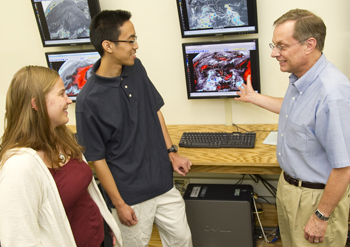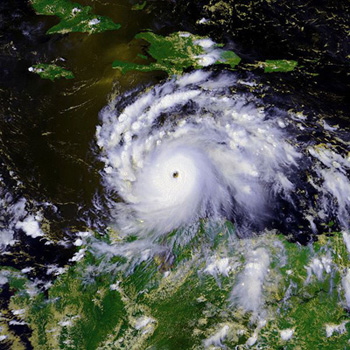Spying the Eyes of Hurricanes
 |
From left, UAlbany graduate students Diana Thomas and Leon Nguyen with Professor John Molinari. They are part of a field study on what makes some storms but not others turn into hurricanes. (Photo Mark Schmidt) |
To understand the mysteries of hurricane formation, UAlbany faculty and students are flying into the eye of storms. They are looking for clues that may help scientists provide more advance warning of hurricanes.
UAlbany graduate students Diana Thomas of Lillington, N.C., and Leon Nguyen of Fresno, Calif., will be flying into storms on a NASA DC-8 with Professor John Molinari Aug. 29-Sept. 11 as part of a field study on what makes some but not others turn into hurricanes and tropical storms.
Molinari and his atmospheric science students will be based in Ft. Lauderdale, Fla., as part of the NASA-supported experiment Genesis and Rapid Intensification Processes (GRIP), focusing on how hurricanes form and why they often intensify rapidly. Professor and Chair Christopher Thorncroft is involved with GRIP as well; his doctoral student, Matt Janiga of Chicago, Ill., will join Thomas and Nguyen in Fort Lauderdale. They are all part of a three-pronged research effort that is sending research scientists to St. Croix and California as well.
"Overall, it is quite an elaborate effort, and our department is heavily involved," said Molinari, professor of atmospheric and environmental sciences.
Thomas has enjoyed the unpredictability of weather ever since she was a girl, observing approaching thunderstorms with her dad Neill.
"Each day is different, no two storms are exactly alike, and the excitement of watching a storm develop has stayed with me," said the second-year master's student, who has found her niche in what she describes as the small, welcoming community of the Department of Atmospheric and Environmental Sciences.
Another group, led by Distinguished Professor Lance Bosart, is flying from St. Croix, U.S. Virgin Islands, Aug. 15 to Sept. 30, as part of Pre-Depression Investigation of Cloud-systems in the Tropics (PREDICT). While Bosart's group is based on St. Croix, a location near where storms often form, it will conduct flights extending thousands of miles from there.
How do Hurricanes Form -- and Not Form
"The real scientific challenge is to understand why so few potential disturbance seedlings develop into tropical cyclones," Bosart said. The goal of PREDICT is to fly research aircraft into seedling disturbances (cloud clusters) to obtain measurements to help scientists find answers to this puzzle.
 |
A cluster of thunderstorms took just days to build into Hurricane Felix in 2007. (Image, courtesy NOAA Satellite and Information Service) |
Assistant Professor Ryan Torn will stay in Albany, taking data supplied by the aircraft and incorporating it into the computer model, to help scientists understand what physical processes limit their ability to predict hurricane formation.
Funding for this experiment from the National Science Foundation and NASA -- in Albany alone -- is more than $800,000 among Bosart, Torn, Thorncroft, and Molinari.
"Ultimately, this work will help us to understand and predict hurricane formation, which remains an unsolved scientific problem," said Molinari. "Many times all the ingredients are there � warm water, persistent intense rainfall, and a pre-existing low pressure area � yet development does not occur, or is delayed for 24-48 hours. We want to understand what processes delay or even prevent tropical cyclone formation, as well as what brings it about."
Doctoral candidates Heather Archambault and Jason Cordeira; Thomas Galarneau, who is receiving his Ph.D. this summer; and Kyle Griffin, a new doctoral student this fall, will help forecast for PREDICT aircraft operations and analyze data collected during the experiment.
The study of "rapid intensification" is a separate phase of hurricane development that brings a storm from a tropical depression or weak tropical storm up to a hurricane. Because this often occurs close to coastal regions and can occur quickly and with little warning, it is especially important to understand.
Unlocking the mystery of rapidly intensifying tropical cyclone formation may one day help scientists give more advance warning to hurricane-vulnerable communities.
The National Oceanic and Atmospheric Administration (NOAA), running the experiment Intensity Forecast Experiment (IFEX) and based at the Hurricane Research Division in Miami, Fla., is the third group involved. Jason Dunion, a doctoral student of Thorncroft's who is starting this fall, is a key participant in this part of the project.
There are seven aircraft involved in the overall project, including the Global Hawk from NASA, an unmanned aircraft that can stay in the air for 36 hours. The Global Hawk flies from Dryden Air Force Base in California.
![]() For more news, subscribe to UAlbany's RSS headline feeds
For more news, subscribe to UAlbany's RSS headline feeds


